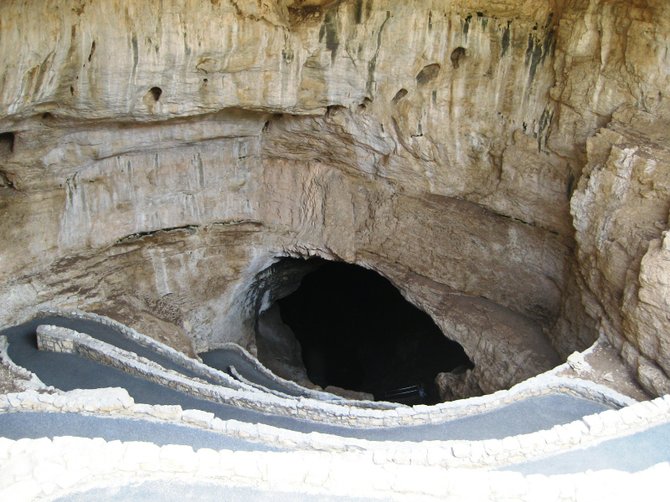 Facebook
Facebook
 X
X
 Instagram
Instagram
 TikTok
TikTok
 Youtube
Youtube

Carlsbad Cavern National Park lies within the limestone Guadalupe Mountain range – the world’s best-preserved Permian-age fossil reef – in what was once a shallow inland sea some 240-plus million years ago.
I talked my friend into going in through the natural entrance, which gives the visitor an idea of what it might have been like for Jim White, who first stumbled into the cave in 1898. Leaving the Visitors Center, we follow the trail down behind the parking lot and past the Bat Flight Amphitheater.
We’d hoped to see the exodus that evening, but were told at the ticket booth that the 400,000 bats had not yet returned from Mexico. Once past the amphitheater, the trail dips, beginning its one-and-a-quarter-mile descent into the earth.
Entering the gapping mouth of the natural entrance of the cave, a series of steep but paved switchbacks, it took us about an hour before we arrived at the Big Room – the equivalent of almost 79 stories below the surface. We strolled around the trail slowly, letting groups of students pass.
We then stopped and sat to take in the essence of the place. Looking up 350 feet, we felt like kids staring up at the ceiling paintings in a great cathedral. At 56°F (13°C) year round, we’d worn our fleece jackets, but after a while of not moving the dampness seeped into our bones.
Carlsbad is home to some of the world’s largest and longest limestone caves – which, unlike other caves around the globe, were carved out by sulfuric acid instead of water. And Carlsbad Caverns, one of the youngest of all the caves formed, is but a single cave within a larger 117-cave system that continues to grow as new ones are discovered.
There we were, in the seventh-largest underground chamber in the entire world, discovered by a sixteen-year-old apprentice cowboy out looking for strays who instead stumbled upon the gaping mouth of the cave after seeing a plume of bats flying into the evening skies to feed.
Sitting there listening to the dripping, we became aware that this place was still in the making. Millions of years old, this antiquity is still growing stalactites, soda straws, draperies and ribbons. Airfield-size rooms adorned with totem poles, flowstone, rimstone dams, lily pads, shelves, cave pools and stalagmites continue to form drip by drip, day by day, year after year.


Carlsbad Cavern National Park lies within the limestone Guadalupe Mountain range – the world’s best-preserved Permian-age fossil reef – in what was once a shallow inland sea some 240-plus million years ago.
I talked my friend into going in through the natural entrance, which gives the visitor an idea of what it might have been like for Jim White, who first stumbled into the cave in 1898. Leaving the Visitors Center, we follow the trail down behind the parking lot and past the Bat Flight Amphitheater.
We’d hoped to see the exodus that evening, but were told at the ticket booth that the 400,000 bats had not yet returned from Mexico. Once past the amphitheater, the trail dips, beginning its one-and-a-quarter-mile descent into the earth.
Entering the gapping mouth of the natural entrance of the cave, a series of steep but paved switchbacks, it took us about an hour before we arrived at the Big Room – the equivalent of almost 79 stories below the surface. We strolled around the trail slowly, letting groups of students pass.
We then stopped and sat to take in the essence of the place. Looking up 350 feet, we felt like kids staring up at the ceiling paintings in a great cathedral. At 56°F (13°C) year round, we’d worn our fleece jackets, but after a while of not moving the dampness seeped into our bones.
Carlsbad is home to some of the world’s largest and longest limestone caves – which, unlike other caves around the globe, were carved out by sulfuric acid instead of water. And Carlsbad Caverns, one of the youngest of all the caves formed, is but a single cave within a larger 117-cave system that continues to grow as new ones are discovered.
There we were, in the seventh-largest underground chamber in the entire world, discovered by a sixteen-year-old apprentice cowboy out looking for strays who instead stumbled upon the gaping mouth of the cave after seeing a plume of bats flying into the evening skies to feed.
Sitting there listening to the dripping, we became aware that this place was still in the making. Millions of years old, this antiquity is still growing stalactites, soda straws, draperies and ribbons. Airfield-size rooms adorned with totem poles, flowstone, rimstone dams, lily pads, shelves, cave pools and stalagmites continue to form drip by drip, day by day, year after year.